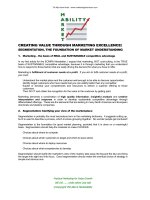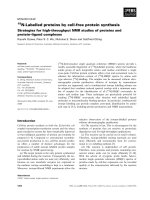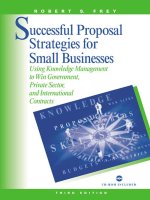Strategies for e business creating value through electronic and mobile commerce doc
Bạn đang xem bản rút gọn của tài liệu. Xem và tải ngay bản đầy đủ của tài liệu tại đây (5.28 MB, 662 trang )
STRATEGIES for e-BUSINESS
We work with leading authors to develop the strongest
educational materials in business, bringing cutting-edge
thinking and best learning practice to a global market.
Under a range of well-known imprints, including
Financial Times Prentice Hall, we craft high-quality print
and electronic publications which help readers to
understand and apply their content, whether studying or
at work.
To find out more about the complete range of our
publishing please visit us on the World Wide Web at:
www.pearsoned.co.uk
STRATEGIES for e-BUSINESS
Creating Value through Electronic
and Mobile Commerce
Concepts and Cases
TAWFIK JELASSI
ALBRECHT ENDERS
Pearson Education Limited
Edinburgh Gate
Harlow
Essex CM20 2JE
England
and Associated Companies throughout the world
Visit us on the World Wide Web at:
www.pearsoned.co.uk
First published 2004
© Pearson Education Limited 2004
The rights of Tawfik Jelassi and Albrecht Enders to be identified as authors of this work have
been asserted by them in accordance with the Copyright, Designs and Patents Act 1988.
All rights reserved. No part of this publication may be reproduced, stored in a retrieval
system, or transmitted in any form or by any means, electronic, mechanical, photocopying,
recording or otherwise, without either the prior written permission of the publisher or a
licence permitting restricted copying in the united Kingdom issued by the Copyright
Licensing Agency Ltd, 90 Tottenham Court Road, London W1T 4LP.
All trademarks used herein are the property of their respective owners. The use of any
trademark in this text does not vest in the author or publisher any trademark ownership
rights in such trademarks, nor does the use of such trademarks imply any affiliation
with or endorsement of this book by such owners.
ISBN 0 273 68840 5
British Library Cataloguing-in-Publication Data
A catalogue record for this book is available from the British Library
Library of Congress Cataloging-in-Publication Data
[insert book block when received from LoC]
10 9 8 7 6 5 4 3 2 1
08 07 06 05 04
Typeset in 10 /12 pt Minion by 30
Printed and bound by MateuCromo Artes Graficas, Spain
The publisher’s policy is to use paper manufactured from sustainable forests.
1
–
2
1
–
2
Foreword xvii
Preface xxv
About the authors xxxii
Acknowledgments xxxv
Part 1 Introduction 1
1 Key terminology and evolution of e-business 3
2 Building e-business competence through concepts and cases
33
Part 2 The e-business strategy framework 57
Introduction to Part 2 59
3 The impact of the Internet on the macro-environment and
on the industry structure
61
4 Markets for e-business
77
5 Value creation in e-business
95
6 Strategy options for value creation in market spaces
121
7 Impact of the Internet on the horizontal boundaries of a firm
135
8 Impact of the Internet on the vertical boundaries of a firm
153
9 Internal organization of a firm’s e-business activities
167
Part 3 Lessons learned 181
10 A roadmap for e-business strategy formulation 183
Part 4 Case studies 195
A guide to main focus of cases 196
Synopses of case studies 197
Case studies
1 Establishing a national IT infrastructure: the case of the French
videotext system Minitel 209
2 Business process redesign at CompuNet: standardizing top-quality
service through IT 224
3 e-Government: the role of information and communication
technologies in the modernization of government 237
v
BRIEF CONTENTS
4 The Euro-Arab Management School 247
5 To be or not to be on the shelf: grocery retailing through the
Internet – Alcampo (Spain) v. Peapod (USA) 253
6 Fighting over the Internet: the virtual battle between Amazon.com
(USA) and Bol.de (Germany) 269
7 Cyber-entrepreneurship: the Nettimarket.com venture in Finland 288
8 The Tesco.com experience: is success at hand? 298
9 ChateauOnline 310
10 Banking on the Internet: the Advance Bank in Germany 325
11 The Electronic Purse in Portugal: a mere payment system or a
socioeconomic revolution? 341
12 From e-banking to e-business at Nordea (Scandinavia): the world’s
biggest clicks-and-mortar bank 355
13 Ducati Motorcycle (Italy): riding traditional business channels or
racing through the Internet 371
14 Ducati (Italy) v. Harley-Davidson (USA): innovating business processes
and managing value networks 386
15 Terra Lycos: creating a global and profitable integrated media company 400
16 Google.com: the world’s number-one Internet search engine 420
17 DoubleClick, Inc.: a strategic transformation 433
18 Competing through EDI at Papeteries Brun Passot: making paper passé 449
19 CitiusNet: the emergence of a global electronic market 462
20 Business-to-business electronic commerce: Mondus.com –
an e-marketplace for small and medium-sized enterprises 480
21 B2B e-marketplace in the automotive industry: Covisint –
a co-opetition gamble? 499
22 eBay strategy A 514
23 eBay strategy B 524
24 eBay international 532
25 Online file-sharing: the music industry’s paradigm shift 539
26 12Snap (Germany, UK, Italy): from B2C mobile retailing to B2B
mobile marketing 554
27 paybox.net (Germany): a mobile payment service 570
28 NTT DoCoMo i-mode: value innovation at DoCoMo 584
Appendix Technologies for electronic and mobile commerce 601
Index 625
Brief contents
vi
PART 1
Foreword xvii
Preface xxv
About the authors xxxii
Acknowledgments xxxv
Introduction
Chapter 1 Key terminology and evolution of e-business 3
Chapter at a glance 3
Learning outcomes 3
Introduction 4
1.1 Key terminology 4
1.1.1 e-Business 4
1.1.2 Electronic commerce 4
1.1.3 Mobile e-commerce 5
FT article: It’s too early for e-business to drop its ‘e’ 5
1.1.4 The concept of strategy 7
Corporate-level strategy 8
Business unit strategy 8
Operational strategy 9
1.1.5 The concept of value creation 10
1.2 The evolution of business 10
1.2.1 The grassroots of e-business 15
FT article: Minitel provides a mixed blessing 17
1.2.2 The rise of the Internet 19
FT article: Burning money at Boo: the founders of the infamous Internet
company were fools rather than knaves 21
1.2.3 The crash 23
FT article: Webvan’s billion-dollar mistake 24
1.2.4 The consolidation phase 26
FT article: eBay leads online revival as net hits the refresh button 28
Summary 29
Review questions 30
Discussion questions 30
Recommended key reading 30
Useful weblinks 31
Notes and references 31
vii
DETAILED CONTENTS
PART 2
Chapter 2 Building e-business competence through concepts and cases
Chapter at a glance 33
Learning outcomes 33
Introduction 34
2.1 Defining creativity and analytical ability 35
2.1.1 Creativity 35
FT article: Breaking the barriers to creativity 36
2.1.2 Analytical ability 39
2.2 Becoming a ‘catalyst for change’ 39
2.3 Learning about e-business through case studies 41
2.3.1 Case studies as a context for the analysis of e-business issues 41
2.3.2 Case studies as a context for the application of e-business concepts 41
2.3.3 Case studies as a stimulus for creative e-business strategies 42
2.4 Learning about e-business through concepts and frameworks 43
Strategy in action 2.1: Business thinking: on finding the right balance between
analysis and intuition 44
2.4.1 Extending the breadth of the analysis 48
2.4.2 Extending the depth of the analysis 49
Strategy in action 2.2: ‘Why?’ – the importance of questions in strategy
formulation 51
Summary 52
Review questions 53
Discussion questions 53
Recommended key reading 53
Useful weblinks 54
Notes and references 54
The e-business strategy framework
Introduction to Part 2 59
Chapter 3 The impact of the Internet on the macro-environment and
on the industry structure
Chapter at a glance 61
Related case studies 61
Learning outcomes 61
Introduction 62
3.1 Examining trends in the macro-environment 62
3.1.1 The political and legal environment 62
3.1.2 The economic environment 63
3.1.3 The social environment 63
3.1.4 The technological environment 64
Detailed contents
viii
3.2 Examining industry structure with the five forces framework 64
3.2.1 Industry rivalry 65
3.2.2 Barriers to entry 66
3.2.3 Substitute products 68
3.2.4 Bargaining powers of buyers and suppliers 69
Critical Perspective 3.1: Co-opetition in e-commerce 70
FT article: Will Amazon.com’s co-opetition gamble pay off? 72
Summary 73
Review questions 73
Discussion questions 73
Recommended key reading 74
Useful weblinks 74
Notes and references 74
Chapter 4 Markets for e-business
Chapter at a glance 77
Related case studies 77
Learning outcomes 77
Introduction 78
4.1 Market segmentation for e-business 78
4.1.1 Segmenting consumer markets for e-business 78
e-Business Concept 4.1: The e-business market segmentation matrix 79
e-Business Concept 4.2: Segments of one and mass customization in the
Internet world 83
4.1.2 Segmenting business markets for e-business 84
Classification of B2B e-marketplaces based on the ‘what’ and ‘how’
of purchasing 84
Classification of B2B e-marketplaces based on their degree of
openness 86
FT article: Covisint fails to move up into the fast lane 87
4.2 Market targeting for e-business 88
Summary 91
Review questions 91
Discussion questions 92
Recommended key reading 92
Useful weblinks 92
Notes and references 93
Chapter 5 Value creation in e-business
Chapter at a glance 95
Related case studies 95
Learning outcomes 95
Introduction 96
5.1 The generic concepts of value creation and value capturing 96
5.1.1 Creating value for customers 96
Detailed contents
ix
Consumer benefit 96
Costs 97
Value created 97
5.1.2 Capturing value 100
5.2 The Internet-impacted value chain 102
5.2.1 Analyzing activities in the value chain 102
e-Business Concept 5.1: Electronic customer relationship management 104
5.2.2 Creating fit between activities 108
Consistency between activities 108
Strategy in Action 5.1: easyJet.com’s low-cost strategy and the Internet 109
Reinforcement of activities 110
Optimization of efforts 111
5.2.3 Leveraging the virtual value chain 111
Strategy in Action 5.2: The virtual value chain at FedEx 113
Critical Perspective 5.1: The resource-based view and core competences 114
Summary 116
Review questions 117
Discussion questions 118
Recommended key reading 118
Useful weblinks 119
Notes and references 119
Chapter 6 Strategy options for value creation in market spaces
Chapter at a glance 121
Related case studies 121
Learning outcomes 121
Introduction 122
6.1 Exploring generic strategies in existing market spaces 122
6.1.1 Achieving competitive advantage 123
Cost leadership 123
Differentiation 124
6.1.2 Getting stuck in the middle 124
Strategy in Action 6.1: Amazon.com CEO Jeff Bezo’s letter to shareholders 125
6.2 Opening up new market spaces 127
6.2.1 Looking outside one’s own box 128
FT article: Dell’s move from PCs into complementary products 129
6.2.2 Pinpointing possibilities for new value creation 132
Summary 132
Review questions 133
Discussion questions 133
Recommended key reading 134
Useful weblinks 134
Notes and references 134
Detailed contents
x
Chapter 7 Impact of the Internet on the horizontal boundaries of a firm
Chapter at a glance 135
Related case studies 135
Learning outcomes 135
Introduction 135
7.1 Concepts of economies of scale and scope 136
7.1.1 Economies of scale 136
e-Business Concept 7.1: Blowing up the trade-off between richness and reach 138
Critical Perspective 7.1: The limitations to blowing up the trade-off
between richness and reach 140
7.1.2 Economies of scope 140
7.2 Timing of market entry 141
7.2.1 Early-mover advantages 141
Learning effects 141
Brand and reputation 142
Switching costs 142
Network effects 144
e-Business Concept 7.2: Virtual outline communities and netwrok effects 145
7.2.2 Early-mover disadvantages 148
Market uncertainty 148
Technological uncertainty 149
Free-rider effects 149
Summary 149
Review questions 150
Discussion questions 150
Recommended key reading 151
Useful weblinks 151
Notes and references 151
Chapter 8 Impact of the Internet on the vertical boundaries of a firm
Chapter at a glance 153
Related case studies 153
Learning outcomes 153
Introduction 154
8.1 Reasons determining ‘make-or-buy’ decisions in e-business 156
8.1.1 Reasons favouring ‘make’ decisions 156
Strong linkage between activities 156
Confidentiality of information 156
High transaction costs 156
8.1.2 Reasons favouring ‘buy’ decisions 157
High economies of scale 158
High capital requirements 158
Specialized know-how 158
Higher efficiency of the open markets 158
8.2 Value-chain deconstruction through the Internet
Critical Perspective 8.1: The limitations of deconstruction and unbundling 159
Detailed contents
xi
PART 3
8.3 Unbundling the corporation through the Internet 161
Summary 163
Review questions 164
Discussion questions 164
Recommended key reading 164
Useful weblinks 165
Notes and references 165
Chapter 9 Internal organization of a firm’s e-business activities
Chapter at a glance 167
Related case studies 167
Learning outcomes 167
Introduction 168
9.1 Choosing options for online interactions with customers 168
9.1.1 Information activities 169
FT article: When customer information turns into ‘spam’ 169
9.1.2 Communication activities 171
9.1.3 Transaction activities 172
9.1.4 Distribution activities 172
9.2 Choosing online/offline distribution channels 172
9.3 Choosing the organizational structure for e-business activities 174
9.3.1 Separate e-business organization 175
FT article: Chapter closes for online books venture 176
9.3.2 Integrated e-business organization 176
Summary 178
Review questions 178
Discussion questions 178
Recommended key reading 179
Useful weblinks 179
Notes and references 179
Lessons learned
Chapter 10 A roadmap for e-business strategy formulation
Chapter at a glance 183
Learning outcomes 183
Introduction 184
10.1 What is the vision for our company? 185
10.2 What are the quantifiable objectives for our e-business activities? 186
10.3 What type of customer value do we want to create through e-business? 186
10.4 What market and customer segments are we targeting through e-business? 187
10.5 What organizational set-up should we have for our e-business activities? 188
10.5.1 What scale should our e-business activities have? 188
10.5.2 What scope should our e-business activities cover? 188
10.5.3 How integrated should our e-business activities be? 189
Detailed contents
xii
PART 4
10.5.4 How should we align our physical-world strategy with our e-strategy? 189
10.5.5 What organizational structure should our e-business activities have? 190
10.6 What is the business model for our e-business activities? 191
10.6.1 What is the cost structure for our e-business activities? 191
10.6.2 What is the revenue structure for our e-business activities? 191
Summary 192
Review questions 193
Discussion questions 193
Recommended key reading 193
Notes and references
Case studies
A guide to the main focus of cases 196
Synopses of case studies 197
IT infrastructure and services
1 Establishing a national IT infrastructure: the case of the French videotext
system Minitel 197
2 Business process redesign at CompuNet: standardizing top-quality service
through IT 197
e-Government
3 e-Government: the role of information and communication technologies in
the modernization of government 198
e-Education
4 The Euro-Arab Management School 198
B2C in retailing
5 To be or not to be on the shelf: grocery retailing through the Internet –
Alcampo (Spain) v. Peapod (USA) 198
6 Fighting over the Internet: the virtual battle between Amazon.com (USA)
and Bol.de (Germany) 199
7 Cyber-entrepreneurship: the Nettimarket.com venture in Finland 199
8 The Tesco.com experience: is success at hand? 200
9 ChateauOnline 200
B2C in financial services
10 Banking on the Internet: the Advance Bank in Germany 200
11 The Electronic Purse in Portugal: a mere payment system or a
socioeconomic revolution? 201
12 From e-banking to e-business at Nordea (Scandinavia): the world’s
biggest clicks-and-mortar bank 201
B2C in manufacturing
13 Ducati Motorcycle (Italy): riding traditional business channels or racing
through the Internet 202
14 Ducati (Italy) v. Harley-Davidson (USA): innovating business processes and
managing value networks 202
Detailed contents
xiii
B2C in media
15 Terra Lycos: creating a global and profitable integrated media company 202
16 Google.com: the world’s number-one Internet search engine 203
17 DoubleClick, Inc.: a strategic transformation 203
B2B e-commerce and B2B e-marketplaces
18 Competing through EDI at Papeteries Brun Passot: making paper passé 204
19 CitiusNet: the emergence of a global electronic market 204
20 Business-to-business electronic commerce: Mondus.com –
an e-marketplace for small and medium-sized enterprises 204
21 B2B e-marketplace in the automotive industry: Covisint –
a co-opetition gamble? 205
C2C e-commerce
22 eBay strategy A 205
23 eBay strategy B 205
24 eBay international 205
P2P e-commerce
25 Online file-sharing: the music industry’s paradigm shift 205
Mobile e-commerce
26 12Snap (Germany, UK, Italy): from B2C mobile retailing to B2B
mobile marketing 206
27 paybox.net (Germany): a mobile payment service 206
28 NTT DoCoMo i-mode: value innovation at DoCoMo 206
Case studies
1 Establishing a national IT infrastructure: the case of the French
videotext system Minitel 209
2 Business process redesign at CompuNet: standardizing top-quality
service through IT 224
3 e-Government: the role of information and communication technologies
in the modernization of government 237
4 The Euro-Arab Management School 247
5 To be or not to be on the shelf: grocery retailing through the Internet –
Alcampo (Spain) v. Peapod (USA) 253
6 Fighting over the Internet: the virtual battle between Amazon.com
(USA) and Bol.de (Germany) 269
7 Cyber-entrepreneurship: the Nettimarket.com venture in Finland 288
8 The Tesco.com experience: is success at hand? 298
9 ChateauOnline 310
10 Banking on the Internet: the Advance Bank in Germany 325
11 The Electronic Purse in Portugal: a mere payment system or a
socioeconomic revolution? 341
12 From e-banking to e-business at Nordea (Scandinavia): the world’s
biggest clicks-and-mortar bank 371
13 Ducati Motorcycle (Italy): riding traditional business channels or
racing through the Internet 386
14 Ducati (Italy) v. Harley-Davidson (USA): innovating business
processes and managing value networks 400
Detailed contents
xiv
15 Terra Lycos: creating a global and profitable integrated media company 400
16 Google.com: the world’s number-one Internet search engine 420
17 DoubleClick, Inc.: a strategic transformation 433
18 Competing through EDI at Papeteries Brun Passot: making paper passé 449
19 CitiusNet: the emergence of a global electronic market 462
20 Business-to-business electronic commerce: Mondus.com –
an e-marketplace for small and medium-sized enterprises 480
21 B2B e-marketplace in the automotive industry: Covisint –
a co-opetition gamble? 499
22 eBay strategy A 514
23 eBay strategy B 524
24 eBay international 532
25 Online file-sharing: the music industry’s paradigm shift 539
26 12Snap (Germany, UK, Italy): from B2C mobile retailing to B2B
mobile marketing 554
27 paybox.net (Germany): a mobile payment service 570
28 NTT DoCoMo i-mode: value innovation at DoCoMo 584
Appendix Technologies for electronic and mobile commerce
1 Introduction 601
2 IT evolution overview 601
2.1 The Internet, intranet and extranet 602
2.1.1 The Internet 602
2.1.2 Intranet 602
2.1.3 Extranet 602
2.2 Client-Server and Peer-to-Peer Models 603
2.2.1 Client-Server 603
2.2.2 Peer-to-Peer (P2P) 603
3 e-Technology 603
3.1 Hardware 603
3.2 Software 604
3.2.1 Operating systems (OS) 604
3.2.2 Browsers 604
3.2.3 Free, open source, commercial 604
3.2.4 Uniform Resource Locators (URL) 605
3.2.5 Internet programming languages and protocols 605
3.2.6 Interfaces 605
3.2.7 Server types, platforms, architectures and infrastructures 606
3.2.8 e-Security 606
3.2.9 The four pillars of e-Security 606
3.3 Networks 610
3.3.1 What is a network? 610
3.3.2 Local area networks (LAN) 610
3.3.3 Wide area networks (WAN) 610
3.3.4 Metropolitan area network (MAN) and campus network 611
3.3.5 Storage area network (SAN) 611
3.3.6 Virtual private network (VPN) 611
Detailed contents
xv
3.4 Applications 611
3.4.1 e-Information 611
3.4.2 Email 611
3.4.3 e-Telephony, voice over Internet Protocol (VoIP) and computer-
telephony integration (CTI) 612
3.4.4 e-Portals 612
3.4.5 e-Marketplaces 612
3.4.6 e-Customer Relationship Management (e-CRM) 613
3.4.7 Enterprise Resource Planning (ERP) 614
3.4.8 e-Supply Chain Management (e-SCM) 614
3.4.9 Data mining 614
3.4.10 e-Content Management Systems (e-CMS) 614
3.4.11 Integrated Services Digital Network (ISDN) and Digital
Subscriber Line (DSL) 615
4 Wireless technology 616
4.1 m-Technology 616
4.1.1 Subscriber Identity Module (SIM) cards 616
4.1.2 Bandwidth and wireless networks 616
4.1.3 Network technologies 617
4.1.4 Service technologies 618
4.1.5 Location technologies 620
4.1.6 m-Security 621
4.1.7 Programming languages and protocols 621
4.2 Devices and applications 622
4.2.1 Devices 622
4.2.2 Applications and services 622
Index 625
Detailed contents
xvi
Foreword to be supplied.
xvii
FOREWORD
Foreword
xviii
Foreword
xix
Foreword
xx
Foreword
xxi
Foreword
xxii
Foreword
xxiii









